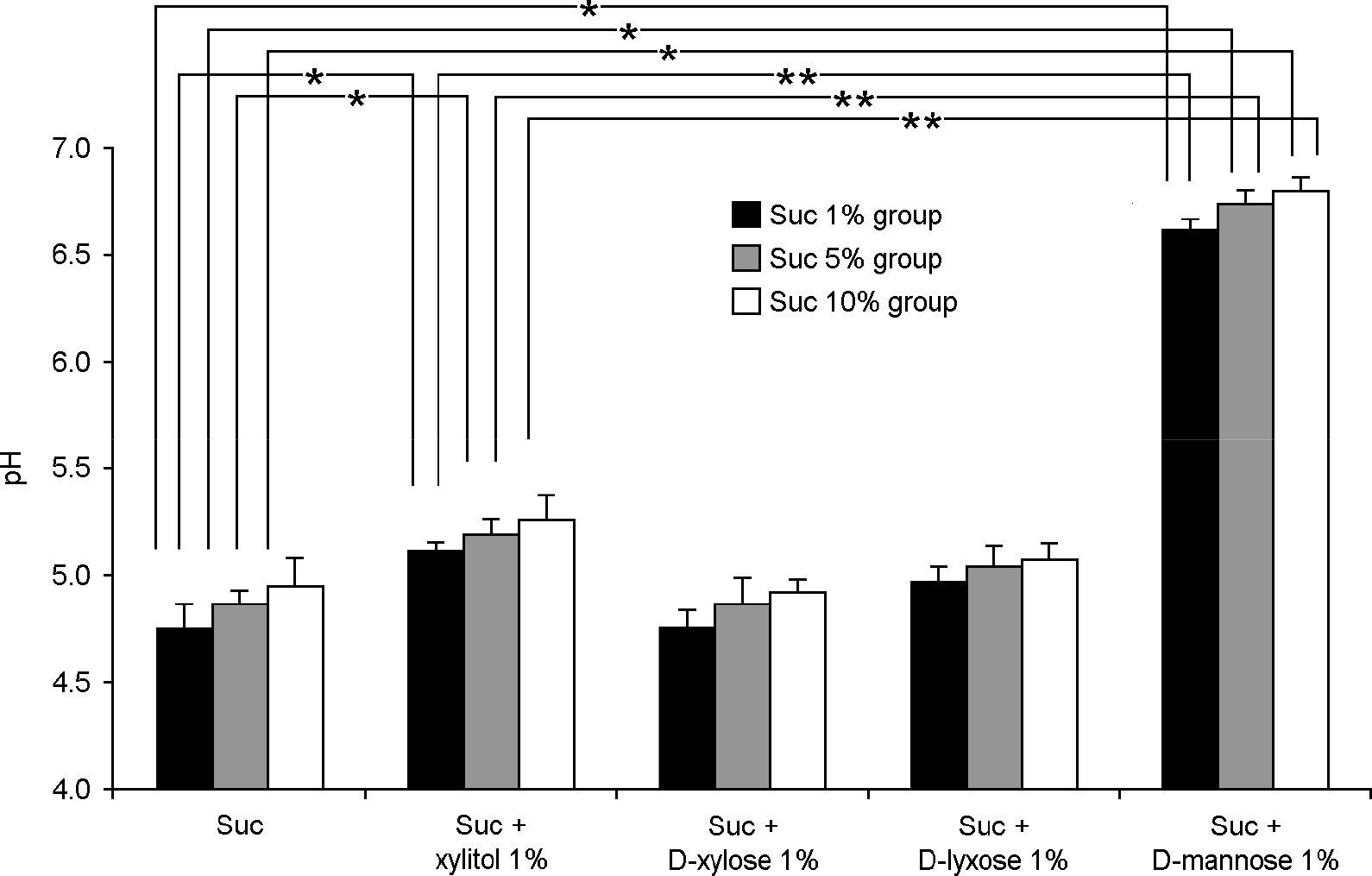J Bacteriol Virol.
2016 Jun;46(2):57-62. 10.4167/jbv.2016.46.2.57.
Inhibitory Effects of D-mannose on Streptococcus mutans in the Presence of Sucrose
- Affiliations
-
- 1Department of Food and Nutrition, Research Institute of Human Ecology, Seoul National University, Seoul, Korea. geji@snu.ac.kr
- 2Research Institute, BIFIDO Co., Ltd., Hongchun, Gangwon, Korea.
- KMID: 2327900
- DOI: http://doi.org/10.4167/jbv.2016.46.2.57
Abstract
- This study aimed to examine the inhibitory effect of rare sugars on Streptococcus mutans (S. mutans) in the presence of sucrose. Xylitol and three rare sugars (D-xylose, D-lyxose and D-mannose) were used in this study. S. mutans KCTC 3065 was cultured in Brain Heart Infusion (BHI) medium containing xylitol, D-xylose, D-lyxose, or D-mannose in the presence of sucrose, and the effect on S. mutans growth was assessed by measuring solution turbidity at different time points after inoculation. To assess effects on pH, sucrose was added at different concentrations, and solution pH was measured at different time points after inoculation. All sugars significantly inhibited the growth of S. mutans in the presence of sucrose. Especially, D-lyxose and D-mannose exhibited significantly greater inhibition than that of xylitol. Furthermore, unlike D-lyxose, D-mannose significantly inhibited the decrement of pH, and its effect was greater than that of xylitol. Taken together, D-mannose has strong inhibitory effect on S. mutans in the presence of sucrose.
Keyword
MeSH Terms
Figure
Reference
-
1). Guggenheim B. Extracellular polysaccharides and microbial plaque. Int Dent J. 1970; 20:657–78.2). Ooshima T, Osaka Y, Sasaki H, Osawa K, Yasuda H, Matsumura M, et al. Caries inhibitory activity of cacao bean husk extract in in-vitro and animal experiments. Arch Oral Biol. 2000; 45:639–45.3). Forbord B, Osmundsen H. On the mechanism of xylitol-dependent inhibition of glycolysis in Streptococcus sobrinus OMZ 176. Int J Biochem. 1992; 24:509–14.4). Lindley MG, Birch GG, Khan R. Sweetness of sucrose and xylitol. Structural considerations. J Sci Food Agric. 1976; 27:140–4.
Article5). Tapiainen T, Kontiokari T, Sammalkivi L, Ikaheimo I, Koskela M, Uhari M. Effect of xylitol on growth of Streptococcus pneumoniae in the presence of fructose and sorbitol. Antimicrob Agents Chemother. 2001; 45:166–9.6). Kakuta H, Iwami Y, Mayanagi H, Takahashi N. Xylitol inhibition of acid production and growth of mutans Streptococci in the presence of various dietary sugars under strictly anaerobic conditions. Caries Res. 2003; 37:404–9.
Article7). Winkelhausen E, Kuzmanova S. Microbial conversion of D-xylose to xylitol. J Ferment Bioeng. 1998; 86:1–14.
Article8). Gong CS, Chen LF, Tsao GT. Quantitative production of xylitol from D-xylose by a high-xylitol producing yeast mutant Candida tropicalis HXP2. Biotechnol Lett. 1981; 3:125–30.9). Takagi Y, Nakai K, Tsuchiya T, Takeuchi T. A 5′-(trifluoromethyl)anthracycline glycoside: synthesis of antitumor-active 7-O-(2, 6-dideoxy-6, 6, 6-trifluoro-alpha-L-lyxo-hexopyranosyl) adriamycinone. J Med Chem. 1996; 39:1582–8.10). Patel DH, Wi SG, Lee SG, Lee DS, Song YH, Bae HJ. Substrate specificity of the Bacillus licheniformis lyxose isomerase YdaE and its application in in vitro catalysis for bioproduction of lyxose and glucose by two-step isomerization. Appl Environ Microbiol. 2011; 77:3343–50.11). Davis JA, Freeze HH. Studies of mannose metabolism and effects of long-term mannose ingestion in the mouse. Biochim Biophys Acta. 2001; 1528:116–26.
Article12). Martin-Villa MC, Vidal-Valverde C, Rojas-Hidalgo E. Soluble sugars in soft drinks. Am J Clin Nutr. 1981; 34:2151–3.
Article13). Nystrom T. Stationary-phase physiology. Annu Rev Microbiol. 2004; 58:161–81.14). Mickenautsch S, Yengopal V. Effect of xylitol versus sorbitol: a quantitative systematic review of clinical trials. Int Dent J. 2012; 62:175–88.
Article15). Mickenautsch S, Yengopal V. Anticariogenic effect of xylitol versus fluoride – a quantitative systematic review of clinical trials. Int Dent J. 2012; 62:6–20.
Article16). Honkala S, Runnel R, Saag M, Olak J, Nommela R, Russak S, et al. Effect of erythritol and xylitol on dental caries prevention in children. Caries Res. 2014; 48:482–90.
Article17). Bader JD, Vollmer WM, Shugars DA, Gilbert GH, Amaechi BT, Brown JP, et al. Results from the Xylitol for Adult Caries Trial (X-ACT). J Am Dent Assoc. 2013; 144:21–30.
Article18). Shallenberger RS. Hydrogen Bonding and the Varying Sweetness of the Sugars. J Food Sci. 1963; 28:584–9.
Article19). Shallenberger RS, Acree TE, Guild WE. Configuration, conformation, and sweetness of hexose anomers. J Food Sci. 1965; 30:560–3.
Article20). Stewart RA, Carrico CK, Webster RL, Steinhardt RG Jr. Physicochemical stereospecificity in taste perception of -D-mannose and -D-mannose. Nature. 1971; 234:220.
Article21). Reid SJ, Abratt VR. Sucrose utilisation in bacteria: genetic organisation and regulation. Appl Microbiol Biotechnol. 2005; 67:312–21.
Article
- Full Text Links
- Actions
-
Cited
- CITED
-
- Close
- Share
- Similar articles
-
- Inhibitory effect of 18β-glycyrrhetinic acid on the biofilm formation of Streptococcus mutans
- Comparison of Cariogenic Characteristics between Fluoride-sensitive and Fluoride-resistant Streptococcus mutans
- Effects of Lactobacillus casei and Aggregatibactor actinomycetemcomitans against Streptococcus mutans according to the Concentration of Sucrose
- The effect of fructose on the metabolism of sucrose by Streptococcus mutans
- Inhibition of nicotine-induced Streptococcus mutans biofilm formation by salts solutions intended for mouthrinses



